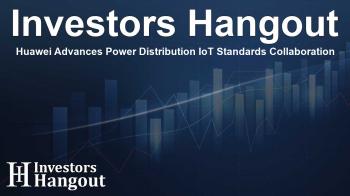Huawei Advances Power Distribution IoT Standards Collaboration

Huawei's Role in Developing Power Distribution IoT Standards
On a significant occasion, Huawei participated in the first in-person Internet of Things (IoT) Architecture Working Group Meeting focused on IEEE P2413.2, which outlines a standard for Reference Architecture for Power Distribution IoT (PDIoT). This gathering brought together key representatives from top power companies, including State Grid, to discuss and shape the future of power distribution through technology.
Highlights from the Working Group Meeting
During this meeting, attendees discussed the foundational outline of the IEEE P2413.2 standard, which is aimed at enhancing the functionalities required for modern power distribution systems. Collaborations among international stakeholders paved the way for substantial progress in drafting the initial version of this essential standard. The meeting marked an essential step towards establishing a globally recognized framework for PDIoT.
Importance of Standards in Digital Transformation
To understand the importance of standards, one must recognize that they serve as the bedrock for any thriving industry. They foster collaboration across various phases of digitalization. With a common understanding of expectations for interfaces and guiding technical pathways, standards significantly influence technological innovation, urging companies to embrace new technologies that align with market shifts.
IEEE's Central Role in Standardization
The Institute of Electrical and Electronics Engineers (IEEE) represents a crucial body in this endeavor, consisting of a vast network of over 460,000 members globally. The IEEE Standards Association focuses on developing standards in emerging technology sectors such as artificial intelligence, quantum computing, and smart devices. Their efforts ensure a consistent approach to technological advancements across varied industries.
The Future of Power Systems with PDIoT
The new power system faces numerous challenges, including adapting to green energy demands, flexible grid controls, and interactive energy consumption methods. Digitalization presents an effective pathway for addressing these challenges. Power Distribution IoT serves as a fundamental building block for smart grids, utilizing interconnected devices to enhance energy efficiency and management practices.
As the digital landscape evolves, the stakeholders in the working group, including Huawei, collaboratively proposed essential features for the PDIoT architecture. This initiative included an innovative cloud-pipe-edge-device structure to optimize energy distribution. Notably, State Grid Shaanxi contributed by presenting 14 application scenarios that align with the PDIoT framework.
Key Insights from Huawei's Leadership
Jason Li, the President of Global Marketing & Solutions for Huawei's Electric Power Digitalization Business Unit, emphasized the need for a cooperative environment to tackle the future power system challenges. He asserted that a unified international standard architecture is vital for fostering intelligent advancements in power distribution networks. His vision aligns with Huawei's commitment to collaborating with global partners, establishing a framework that is adaptable and sustainable.
Meeting the Challenges of Digital Transformation
The creation of IEEE P2413.2 international standards seeks to address the unique needs of power distribution throughout the ongoing digital transformation of the global electricity sector. This effort aims to enhance communications within high-speed power line networks, ensuring a seamless exchange of information vital for modern power systems.
Frequently Asked Questions
What was the purpose of the IEEE P2413.2 meeting?
The meeting aimed to discuss and propose standards for the Reference Architecture for Power Distribution IoT (PDIoT), focusing on enhancing international collaboration in the power sector.
Who participated in the meeting?
Key representatives from companies such as State Grid of China and several European power firms took part in the discussions.
Why are standards important in the power sector?
Standards promote industry digitalization, ensuring unified expectations for interfaces and driving innovation by guiding technical pathways.
What role does IEEE play in technology standardization?
IEEE is the largest technical professional organization worldwide, setting standards in various technology sectors, including those related to AI and electrical devices.
How does Huawei contribute to power distribution enhancements?
Huawei collaborates with global partners to develop frameworks that are open and sustainable, ensuring technical innovations in power distribution networks.
About Investors Hangout
Investors Hangout is a leading online stock forum for financial discussion and learning, offering a wide range of free tools and resources. It draws in traders of all levels, who exchange market knowledge, investigate trading tactics, and keep an eye on industry developments in real time. Featuring financial articles, stock message boards, quotes, charts, company profiles, and live news updates. Through cooperative learning and a wealth of informational resources, it helps users from novices creating their first portfolios to experts honing their techniques. Join Investors Hangout today: https://investorshangout.com/
Disclaimer: The content of this article is solely for general informational purposes only; it does not represent legal, financial, or investment advice. Investors Hangout does not offer financial advice; the author is not a licensed financial advisor. Consult a qualified advisor before making any financial or investment decisions based on this article. The author's interpretation of publicly available data shapes the opinions presented here; as a result, they should not be taken as advice to purchase, sell, or hold any securities mentioned or any other investments. The author does not guarantee the accuracy, completeness, or timeliness of any material, providing it "as is." Information and market conditions may change; past performance is not indicative of future outcomes. If any of the material offered here is inaccurate, please contact us for corrections.
